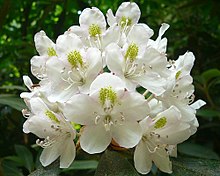Rhododendron maximum
| Rhododendron maximum | |
|---|---|
 |
|
| Flower cluster | |
| Scientific classification | |
| Kingdom: | Plantae |
| (unranked): | Angiosperms |
| (unranked): | Eudicots |
| (unranked): | Asterids |
| Order: | Ericales |
| Family: | Ericaceae |
| Genus: | Rhododendron |
| Subgenus: | Hymenanthes |
| Species: | R. maximum |
| Binomial name | |
|
Rhododendron maximum L. |
|
 |
|
Rhododendron maximum — its common names include great laurel,great rhododendron, rosebay rhododendron, American rhododendron and big rhododendron — is a species of Rhododendron native to the Appalachians of eastern North America, from Alabama north to coastal Nova Scotia.
Rhododendron maximum is an evergreen shrub growing to 4 m (13 ft), rarely 10 m (33 ft), tall. The leaves are 9–19 cm (3–8 in) long and 2–4 cm (0.75-1.5 in) broad. The flowers are 2.5–3 cm (1 in) diameter, white, pink or pale purple, often with small greenish-yellow spots. The fruit is a dry capsule 15–20 mm (.60-.79 in) long, containing numerous small seeds. The leaves can be poisonous. Leaves are sclerophyllous, simple, alternate, and oblong (10 to 30 cm long, 5 to 8 cm wide). It retains its waxy, deep-green leaves for up to 8 years, but once shed are slow to decompose. It produces large, showy, white to purple flowers each June.
Rosebay [1] rhododendron is the most frequently occurring and dominant species of Rhododendron in the southern Appalachian region (Swanson 1994), and occurs occasionally on mesic hill-slopes throughout the upper Piedmont Crescent of the Southeastern United States.
Approximately 12,000 square miles in the southern Appalachians are occupied by this species (Dobbs 1995) where it dominates the understory. This species has historically been confined to riparian areas and other mesic sites but takes advantage of disturbed areas where it is present to advance onto sub-mesic sites. It prefers deep well-drained acid soils high in organic matter where it produces a thick, peat-like humus. It prefers low to medium light conditions for optimum carbon gain, and has a tremendous capacity for avoiding cavitation during freeze-thaw cycles (Lipp and Nilsen 1997). Where extensive overstory mortality has eliminated most of the overstory, this species forms a thick and continuous subcanopy known locally as ‘laurel slicks’ or ‘laurel hells’. Rosebay rhododendron is an important structural and functional component of southern Appalachian forest ecosystems. What isn’t clear is whether or not we are in a period of advancement or retreat for this species. For example, on poorly drained sites on ridge or upper slope positions, large areas of rosebay rhododendron, particularly at the high elevations, have recently died out presumably due to the phytophthora fugus, or due to recent prolonged periods of below-average precipitation. Yet, rosebay rhododendron now occupies sites that historically were free of evergreen understory. There are still important questions to be answered regarding this species to completely understand its role in forest understories.
...
Wikipedia
